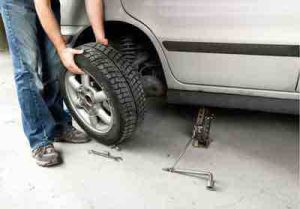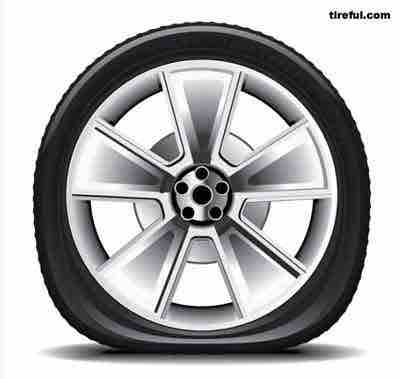You thought of going to get some groceries, you stepped in your car and your tire pressure light came on indicating one of your tires is getting low.
That’s the TPMS (Tire pressure monitoring system) indicator that shows that your tire pressure may be low and should be checked and it’s a light seen on the dashboard.
It is not a friendly reminder light but a warning light. You keep staring at the tires and wondering what might be wrong with them because they are not visibly flat.
“Why not do what the indicator says; check the tires,” you thought. Yes! You have to check your tire pressure, you hastily got a tire pressure gauge to know the correct PSI (Pounds per square inch) your tire is reading.
OMG! You just lost 10 PSI overnight, the tire gauge record is lower than the recommended PSI for your tires and it seems to be the tires were in good shape the previous day.
Now, what next?
Simply fill the tires with air but do not be in a rush as you first have to find the source of the slow leak because you might be wondering why lose 10 PSI when there is no visible hole or puncture.
Table of Contents
This is what you should do when your tire loses 10 PSI overnight

- Inspect the tire
- Use soapy water
- Dip the tire into water
- Patch or plug the tire
- Apply a bead sealer
- Inflate the tire
Inspect the tire
You have to take a thorough inspection of the tire which requires removing it from the vehicle, the slow leak may be a result of a very small hole in the tread or sidewall.
Sometimes the tire may not be the issue, it might be the air valve stem has a leak and needs to be replaced, or maybe the tire bead (Where the tire meets the wheel) might be loose and not be sealed properly against the rim.
Use soapy water
You can also find the source of the slow leak with soap and water or water exclusively.
This is what you have to do, mix liquid soap with water in a spray can and spray all parts of the tire; the thread, the valve stem and opening, sidewalls, and through the rim on both sides.
Continue spraying every part until you see a spot where bubbles begin to form, the part you see bubbles is where the air is leaking.
This is a very easy step or method to take in DIY repairs. With the wheel on the car, it is not difficult to do.
But you might also be able to do it without taking the wheel off, especially the front of the tires because as you turn the steering wheel, it exposes the inner sidewall to some extent.
Dip the tire into water
Another way to find a leak is to remove the tire and the wheel from the car and dip them into a tub of water, bubbles will immediately form at the spot of the leak.
Patch or plug the tire
Small holes and small punctures in the thread can also cause a leak and make a tire PSI reduce, the leak can be patched or plugged.
You should know that a large puncture cannot be patched or plugged, so also is any small damage to the sidewalls or shoulders.
Damages like this typically call for a new tire replacement.
Apply a bead sealer
Sometimes you can find that the wheel isn’t fully seated against the tire and this can lead to a slow leak, what you have to do is stop the leak, simply remove the tire and apply a bead sealer.
When the leak is within the wheel bead seat, remove the tire, wipe off any corrosion and apply a bead sealer before fixing it back to the tire.
Inflate the tire
Some mechanics may suggest you inflate the tire with nitrogen instead of air because nitrogen molecules are larger than oxygen possibly making them less able to pass through a hole causing a leak.
Although nitrogen contains less moisture, this prevents rust if the wheel is made of steel.
Other mechanics will suggest you grind off corrosion. This takes a lot of time and labor that might cost you to get a used or new wheel.
When a slow leak results from a wheel, it will be the final call as to whether it can be repaired or replaced like pitting in the wheel will cause air to leak even more
Did you just find out your tire lost 10 PSI? Find the source of the leak, plug, or patch.
If the source is from a small puncture or pinhole, apply a bead sealer if the wheel isn’t seated snugly against the tire, or call a professional repairer for proper inspection.
What can make a tire lose 10 PSI overnight?
“I checked my tire’s pressure yesterday morning and filled them to the right PSI, but why did it drop overnight?”
Well, it is key to always keep the right tire pressure in your car’s tires.
Same reason every manufacturer recommends checking it more often, we also recommend that checking your car tire pressure regularly will help avoid future inconveniences.
However, you might get to see that your tire loses air pressure in certain cases, often, after a month of filling it.
Sometimes, you’ll notice a drop of PSI overnight despite checking and inflating it the previous day.
Basically, the loss of pressure in a tire or decrease in PSI doesn’t always mean your tires have been punctured and that you had to go to the repairer’s shop immediately in a complete “Worried mode”.
In some cases, it is okay if your tire deflates over time of use or in rare events, sometimes because of atmosphere conditions – as long as the pressure loss is not that worse – what’s worse and what’s not?
Here, we’ve outlined possible causes that might make a tire lose 10 PSI overnight;
- Punctures
- Temperature changes
- Poor valve stems
- Permeation
- Impact breaks
Punctures
Definitely, a puncture in a tire will lead to a tire losing air pressure. A hard or sharp object may cause one or more punctures to your car’s tire if you drive over them.
You should inspect your tires to know if they are punctured especially if you are finding it difficult to maintain the correct amount of air pressure.
Common sources of tire punctures include; Screws, broken glass, nails, and sharp rocks.
Temperature change
Temperature change is another possible reason for your tire to lose pressure.
You might have taken note that there’s a slight difference in the tire pressure on a sunny day compared to a cold day.
This is due to temperature playing a big factor when it comes to the behavior of air molecules. There will be an increase in pressure if the air molecules inside a tire are expanded when expose to heat.
Conversely, in colder weather, the temperature will make the molecules in your tire contract and that is the reason you sometimes experience lower tire pressure.
It is advisable to check your tires when they are not hot or when the weather is extremely cold. By doing this, you will get the correct tire pressure reading.
Poor valve stems
You should always check and ensure that your valve also is in good condition.
Inspect the seal and check if the valve is allowing air in through the pump and settling properly, when you do this, it reduces the rate of your tires passing through anything that has pores.
It’s rare for valve stem caps to fall off and you may feel a missing valve may seem harmless but can lead to loss of air pressure.
The absence of the cap will make dirt and debris break through the seal, air will leak out of the tire vis the valve stem if this occurs.
Even if the valve stem is in a good condition, a degraded valve stem may lose air pressure too. They are typically made with plastic and plastics ate waterproof, it does not make them resistant to damage.
Permeation
Permeation can also be one of the possible reasons why your tire could lose its PSI, you may wonder what a Permeation is, because it sounds scientific, it is the diffusion of a molecule through a membrane.
You know a tire can hold air for a long time, but due to the permeation and sizes of the air molecules with the membrane of your tire, air can gradually escape through.
There is no cause for alarm as it occurs naturally and can be easy to solve if you visit a gas station to get more air.
Impact breaks
Road bumps can also cause your tires to lose air pressure especially when parking or trying to maneuver curves.
This is caused by impact break caused by speed bumpers, hitting curbs, or any object that stresses the sidewalk of the tire and will possibly damage the cords within to break; and can lead to tire problems including tire pressure loss.
However, you should remember that regardless of these credible reasons for a decrease in PSI or loss of tire pressure, it is very important to be mindful that as soon as your tires are repeatedly losing pressure after filling to the correct amount of air, you should seek professional inspection.
What about if tire lost 5 psi overnight?
If your tire lost 5 PSI of air pressure overnight, it may indicate a leak or temperature change.
A decrease in temperature can cause the tire pressure to drop, while a puncture or damaged valve stem can cause air to leak out.
To fix the issue, first, check the tire pressure using a tire gauge, then inflate the tire to the recommended pressure level.
If the tire continues to lose pressure, inspect it for punctures or damage. If you find any, repair or replace the tire accordingly.
Tire losing pressure but no leak: causes and solutions
If you have noticed that your tire is losing pressure but you can’t seem to find any punctures or leaks, One possible cause is a damaged valve stem.
- The valve stem is the part of the tire that allows you to add or release air pressure. Over time, the valve stem can become damaged or worn, causing air to leak out. In this case, replacing the valve stem is the best fix.
- Another potential cause is a corroded or damaged wheel rim. If the rim is not sealing properly with the tire, air can leak out. In this case, cleaning or replacing the rim may be necessary.
- It’s also possible that the tire bead isn’t seated properly on the rim. This can happen if the tire is not installed correctly or if the tire is old and worn. Try reseating the tire on the rim or replacing the tire.
- Remember that the TPMS could be malfunctioning, giving you the wrong signals. In this case, you’ll need to have the system diagnosed and repaired by a professional.
In my personal experience, I once had a tire losing pressure without any visible punctures or leaks. After checking the valve stem and rim, I discovered that the TPMS was malfunctioning, and replacing it solved the issue.
Related topics:
- Will a 3-gallon Air Compressor Fill a Car Tire
- Do You Need A Torque Wrench to Change Tires
- How to tell if Someone put a Nail in your Tire
- Can A Pothole Cause a Flat Tire

